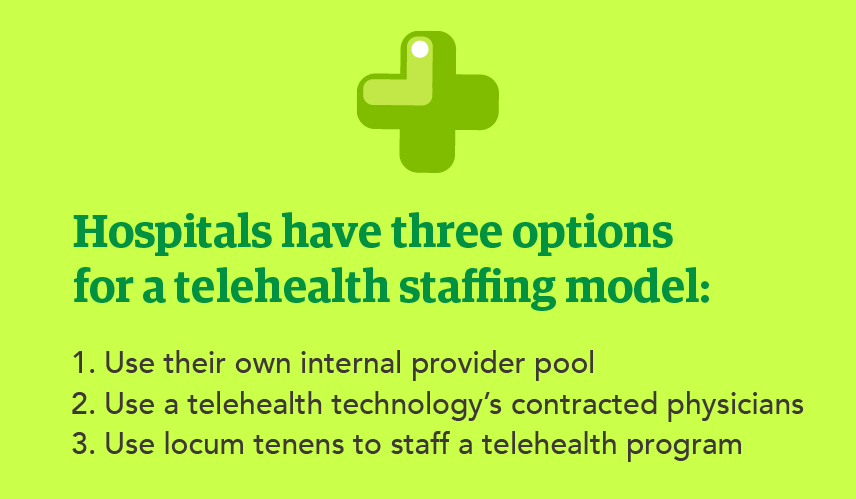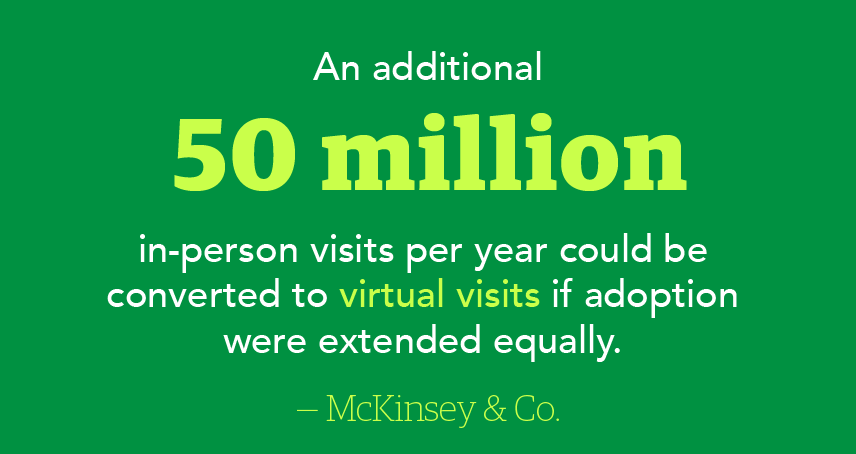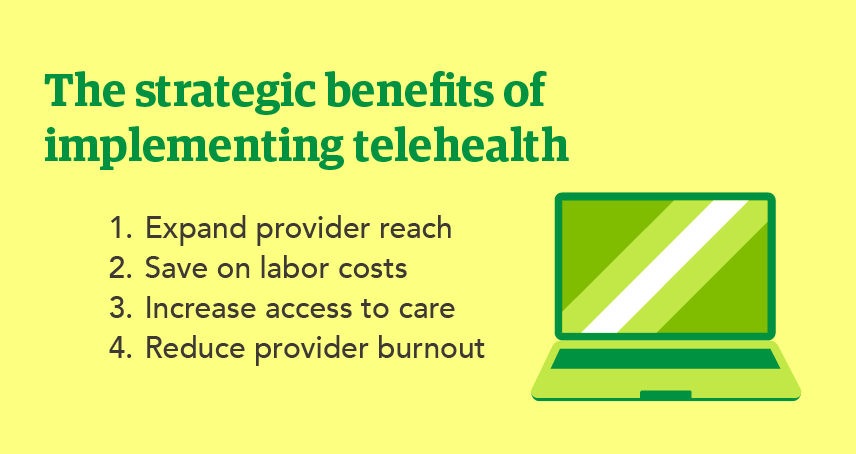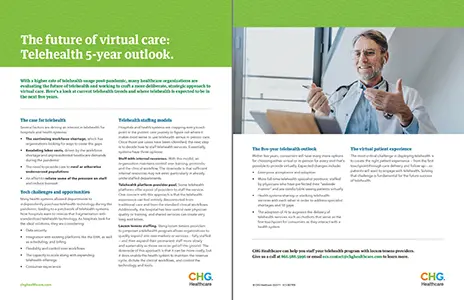
Health systems are faced with several challenges as they consider how to expand telehealth in the future. In the past, many hospital departments purchased and deployed telehealth technology as quickly as they could, leading to a patchwork legacy of disconnected systems that were challenging to staff and difficult to maintain. Now, many health organizations are working to reverse that fragmentation by deploying one standardized technology systemwide and developing more mature telehealth staffing models with an eye for the growing patient demand for virtual care.
Telehealth technology challenges and opportunities
Finding that one solution can be more complicated than it sounds, however. The solution needs to be highly secure and integrate with their existing platforms for scheduling, billing, electronic health record, and rounding solutions, among others. Health systems are also looking for a solution that gives them flexibility and control over workflows. Additionally, they need the ability to scale, so they can continue to grow their telehealth presence over the long term.
When it comes to telehealth technology, the consumer experience is another key consideration. The digital-first population—so-called digital natives—want their first entry into the care journey to be virtual. With the digital front door model, patients can use an app or online platform to connect with a care provider, who may route them onward to a telehealth specialist if necessary.

Settling on a telehealth staffing model
The thorniest telehealth problem is determining its ideal use cases. Many healthcare organizations are looking at every specialty and every role within a facility to identify every use case—even examining it at the claim level. Essentially, they are journey-mapping every touchpoint in the care journey to figure out where it makes most sense to use telehealth versus in-person care.
Once those use cases have been identified, the next step is to decide how to staff telehealth services. Essentially, hospitals have three options: first, using their own physicians; second, using the pool of providers that comes with the technology they’ve adopted; or third, turning to a locum tenens agency or other staffing service to help staff the telehealth program.

Staffing telehealth with internal resources
There are both pros and cons to a telehealth technology-only solution that uses internal clinicians for staffing. The primary benefit is that the organization maintains total control over cost, training, protocols, and the clinical workflow. The downside is that sufficient internal resources may not exist, particularly in already understaffed departments, which can make staffing a challenge and contribute to provider burnout.
Develop your telehealth staffing strategy: Integrating physicians into virtual care
Telehealth platform provider pool
Using the provider pool that comes with a technology platform can be a simple, turnkey solution for hospitals. The tradeoff is that the telehealth experience can feel entirely disconnected from traditional care and from the standard clinical workflows. Additionally, the hospital will have less control over physician quality or training.
Another downside is that many of these services require a two- or three-year commitment. If the telehealth services aren’t embraced by consumers, hospitals are stuck in a contract that may be difficult to get out of.
Locum tenens telehealth staffing
Many organizations are seeing success using locum tenens providers to jumpstart a telehealth program. This allows them to quickly expand into new markets or services—fully staffed—and then expand their staff more slowly and sustainably as those services get off the ground. The downside of this approach is that it can be more costly, but it does enable the health system to maintain the revenue cycle, dictate the clinical workflows, and control the technology and tools.
Additionally, locum tenens physicians typically have experience adapting to new environments and new technologies, and many have telehealth experience. Plus, they often already have multiple state licenses, reducing the time needed to get them ready to work.
The five-year telehealth outlook
Health systems are working tirelessly to deploy more telehealth offerings wherever possible. As a result, within three to five years, consumers will have many more options for choosing either virtual or in-person for every visit that’s possible to provide virtually. Using national claims data, McKinsey & Company estimates that more than 50 million in-person additional visits per year could be converted to virtual visits if adoption were extended equally.

What is happening in 2025: 7 telehealth trends: Innovation surges, but policy lags
Virtual care experts
One change is certain: In the next five years, more physicians will be experts at virtual care. Those with telehealth experience are already learning to perfect their “web-side manner” and feel comfortable with seeing patients virtually. Similarly, hospitals will have full-time telehealth specialists and even chief virtual care officers.
Specialist sharing across health systems
Another change will be a greater appetite among health systems for sharing or stacking telehealth services with each other. With ongoing and persistent specialist shortages, organizations are realizing they are going to need to share these in-demand physicians with other systems. Telehealth offers an intuitive way to share those resources.
Artificial intelligence and virtual care
The biggest buzzword in every industry is artificial intelligence, and healthcare is not immune to AI speculation. Automation or artificial intelligence may be a way to augment telehealth. For example, AI chatbots could serve as the first touchpoint for consumers as they interact with a health system, directing patients to the right care faster.
The virtual patient experience
The most critical challenge in deploying telehealth is to create the right patient experience—from the first touchpoint through care delivery and follow up—so patients will want to engage with telehealth. Solving that challenge is fundamental for the future success of telehealth.
The strategic benefits of virtual care
Any hospital or health system that was on the fence about telehealth services prior has now firmly fallen on the side of strategic adoption. A few trends are driving that interest in telehealth.

1. Healthcare workforce shortage
The continuing, massive healthcare workforce shortage has health systems looking for ways to fill gaps in care, particularly in rural or underserved areas. Telehealth is a way to expand the reach to more patients with fewer providers, especially for high-shortage specialties such as psychiatry, medical oncology, and urology.
2. Labor cost savings
Second is an effort to bring labor costs under control. The workforce shortage, combined with unprecedented healthcare demands during the pandemic, has driven staffing costs significantly higher. One study found that telehealth reduced costs to the health system by more than 50%.
3. Increased access to care
Third is the ability to provide care to populations that don’t have easy access to certain specialties due either to their geographic location or a specialty physician shortage, a challenge telehealth is uniquely positioned to help address. Some organizations are using virtual care to fill smaller care gaps, enabling them to deploy specialty consults as needed rather than hiring full-time providers when there’s only part-time demand.
4. Reduced provider burnout
And finally, hospital systems hope telehealth care relieves some of the pressure on their physicians, helping tackle the problem of burnout. However, there’s still the challenge of staffing telehealth programs with either existing staff providers or locum tenens physicians trained for telehealth.
Download: The future of virtual care: Telehealth 5-year outlook

Interested in learning more about staffing your telehealth program with locum tenens providers? Give us a call at 866.588.5996 or email ecs.contact@chghealthcare.com.